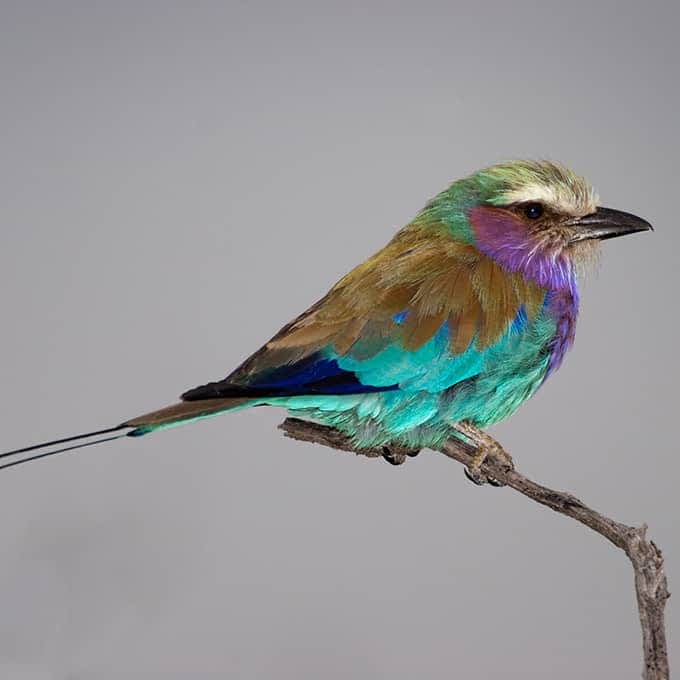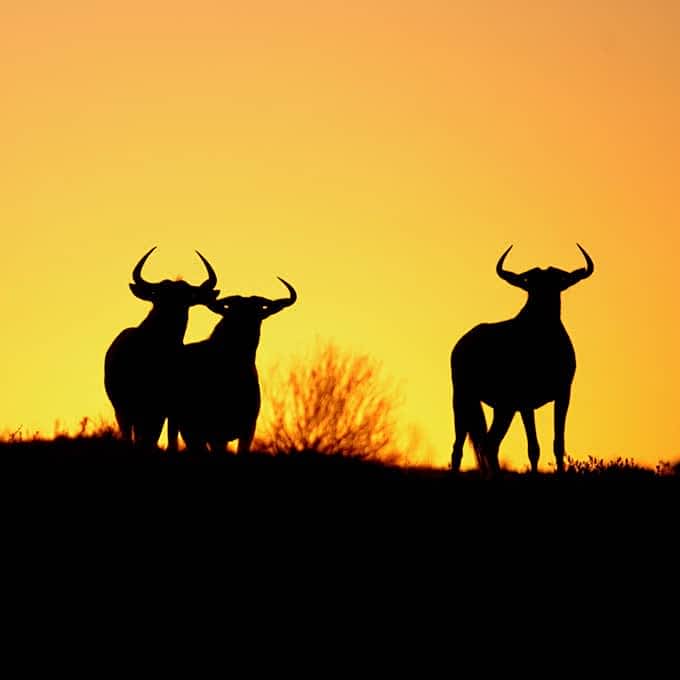The Big Nine
In addition to the so-called 'Big Five', the lion, elephant, leopard, rhino and buffalo, the Mara is home to a wide variety of other species of wild animals. Below you'll find a summary of animals you may come across during your visit to the Masai Mara.
Why stop at the 'Big Five' when you can spot the 'Big Nine'? The group of wild animals known as the 'Big Nine' is made up of the Big Five plus the giraffe, cheetah, hippo and zebra. Chances are good that you'll spot most of them when on safari in the Masai Mara. Here's a look at these four Big Five add-ons that you'll want to spot during your safari.
Giraffe (Giraffa)
The Masai giraffe (Giraffa camelopardalis tippelskirchii) is the tallest of all land animals is an extraordinary sight to see. The giraffe is known for its graceful movements and for being very picturesque. At top speed, the giraffe can run up to 50-60 hours per hour. Kenya is home to different giraffe (sub)species. In Northern Kenya you'll see the reticulated or Somali giraffe. Particularly rare is Rothschild's giraffe (about which there is ongoing discussion whether it concerns an actual subspecies). In Southern Kenya, you'll come across Masai giraffes. Masai giraffes are different from reticulated giraffes in that they have jagged spots on their bodies, instead of polygonal liver-coloured spots. Approximately 33,000 Masai giraffes live in this region and most of them live in small groups. Approximately 16 - 20 hours of their day is spent feeding. Their favourite snack? Acacia tree leaves. Their long tongues and lips craftily avoid the Acacia tree thorns to snack on the tree’s leaves. As long as they have fresh vegetation, they can go without water for weeks. Typically the male giraffes eat from the top branches of the Acacia trees and the females eat from the bottom branches. Their greatest enemies are hyena, lions and poachers. Their greatest defence is their ability to flee at high speed and if necessary they pack a mean and powerful kick.
Cheetah (Acinonyx jubantus)
One of the most iconic animals in the Masai Mara is the cheetah. It hunts out in the open in groups of up to five cheetahs. These big cats have flexible spines that can flex and straighten. This in combination with their powerful hind legs allows them to reach incredible speeds of up to 110 kilometres an hour. In just three strides they can accelerate from 0 to 64 kilometres per hour. Their very long tails are used as rudders and enable cheetahs to make sharp turns when chasing their prey. Although they are at times confused with leopards, the cheetah is in fact slimmer and has a longer body frame. Its face is also smaller and rounder than that of a leopard. Female cheetahs live solitary, male cheetahs however do not. The females only interact with adult male cheetahs in order to breed, but raise their cubs on their own. When the cubs are eighteen months old, the mother leaves the cubs to fend for themselves. The sibling cubs generally stay together in a pack for approximately six months. At around the two year mark, the female siblings leave the group to live solitary lives. The male siblings stick together for life and form a ‘coalition’. A coalition generally consists of two to three siblings and is a very tight-knit group. Cheetahs hunt in the early morning and late afternoon and generally prey on small antelopes, but also enjoy hunting kudu, warthog, hartebeest, oryx, sable and road. They are also known to eat game birds and rabbits. Unfortunately the cheetah is now classified as a critically endangered species by the IUCN due too a sharp decline in the number of cheetahs over the years. It is believed that there are only 10,000 to 12,000 cheetahs left living in the wild.
Hippo (Hippopotamus amphibius)
The hippo is the third largest land animal and on average an adult male weighs in at nearly 1500 kilograms on average. You’ll come across hippos in rivers, swamps and along lake shores. They love to spend their days keeping cool in water and mud. At dusk they leave the water to graze on grass. There are large numbers of hippo in the Masai Mara National Reserve. Male hippos (bulls) rule over a particular stretch of river and generally have five to 30 female hippos and their young to watch over. The hippo is one of the most aggressive animals in the world and therefore one of the most dangerous animals in Africa. Approximately 125,000 to 150,000 hippos live throughout Sub-Saharan Africa.
Zebra (Equus quagga)
The Masai Mara is home to large herds of plains zebras. This type of zebra is slightly smaller than the Grevy’s zebra, yet larger than the mountain zebra. Its stripes are also broader than both of the other types of zebras. Plain zebra’s live in treeless grasslands and savanna woodlands and can be found in either tropical or temperate climates. These zebras are hunted by lions, spotted hyenas, crocodiles, cheetahs and African wild dogs. The plains zebra is a very social species. They form harems consisting of one single male stallion, several female mare zebras and their young. Aside from these family groups, there are also bachelor male zebra groups. At times several groups join to create herds that work together to keep watch for predators. When a predator is spotted, the stallion of the herd snorts or barks to protect his harem.
Other Masai Mara animals
There's so much more to the Masai Mara than the Big Five and the Big Nine. Here’s a list of some of the unique and interesting mammals roaming this part of Africa.
Aardvark (Orycteropus afer)
Aardvarks are small burrowing animals with long snout and powerful claws. These nocturnal animals are native to Africa and feed on insects such as ants and termites. They are hairless, have short legs and thick claws for burrowing and digging.
Aardwolf (Proteles cristatus)
This yellowish animal with black stripes and a bushy, black-tipped tail looks like a small striped hyena. It has a very coarse ridge of hairs along the length of its back and it has longer front legs than hind legs. They are solitary animals and are active at night.
African Hare (Lepus capensis)
The African hare is found in wooded savannas and grasslands throughout Africa. They are solitary creatures, but when it comes time for dinner they at times pair up in twos or threes to keep safe from predators.
Banded Mongoose (Mungos mungo)
This type of mongoose is most commonly found in central and eastern Africa. They live in savannahs, forests and grasslands. Their homes include termite mounds and they generally live in colonies. They are either brown or grey and have dark bands on their back that reach from shoulder to tail.
Even more land animals in the Masai Mara
- Bat Eared Fox (Otocyon magalotis)
- Bushbaby (Galago senegalensis)
- Bushbuck (Tragelaphus scriptus)
- Coke’s Hartebeest (Alcelaphus buselaphus cokii)
- Common Eland (Taurotragus oryx)
- Copper Tailed Monkey/ Red Tailed Monkey (Cercopithecus Ascanius)
- Crested Porcupine (Hystrix cristata)
- Dwarf Mongoose (Helpgale parvula)
- Grant’s Gazelle (Gazella granti)
- Honey Badger (Mellivora capensis)
- Impala (Aepyceros melampus)
- Kirk’s Dik-Dik (Madoqua kirkii
- Klipspringer (Oreotragus oreotragus)
- Olive Baboon (Papio cynocephalus Anubis)
- Oribi (Ourebia ourebi)
- Pangolin (Manis temminckii)
- Side Striped Jackal (Canis adustus)
- Slender Mongoose (Herpestes sanguineus)
- Spotted Hyena (Hyaena hyaena)
- Spring Hare (Pedetes capensis)
- Straw Coloured Fruit Bat (Eidolon helvum)
- Thomson’s Gazelle (Gazella thomsonii)
- Topi (Damaliscus lunatus jimela)
- Vervet Monkey (Cercopithecus aethiops)
- Warthog (Phacochoerus africanus)
- Waterbuck (Kobus ellipsiprymnus)
- Wildebeest (Connochaetes)
Further reading










